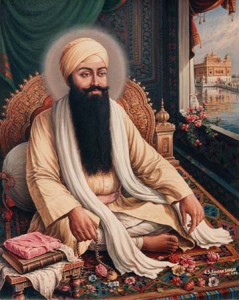
Name : Sri Guru Ramdas Ji
Date of Birth : 1534 A.D.
Place of Birth : Chuni Mandi in Lahore, now in Pakistan
Father : Bhai Han Das
Mother : Mata Daya Kaur
Mahal(Wife) : Bibi Bhani
Sahibzade(Sons) : Baba Prithi Chand,Baba Maha Dev,Arjan Dev
Accession to Gurugaddi : 1574 A.D. at Goindval.
Date of Eternal Rest : 1581 A.D.
Place of Eternal Rest : Goindval in Amritsar.
Succession to Gurugaddi : Guru Sahib nominated his youngest son Arjan Dev as the fifth Guru.
Cities Founded and Construction Work :
City of Amritsar in 1574 A.D., earlier known as Chakk Guru ka and Ramdaspur.
Excavation of Amrit Sarovar (Pool of Nectar) at Golden Temple in Amritsar.
Bani :
Total number of hymns 638 in 30 Ragas, e.g. Asa, Basantu, Gauri, Majh, Ramakali and Suhi etc. Guru Sahib composed Four Lavan in Rag Suhi, consisting of thirty eight stanzas, symbolically representing the union of Soul with the Supreme Being. This Bani now forms an integral part of the ceremony of the marriage of the Sikhs.
Ruler of the Time : Emperor Akbar (r. 1556-1605 A.D.)
Emperor Jahangir (r. 1605-1626 A.D.)
His Message
To be true Sikhs.
To imbibe the Name of God.
To Sing the Glory of the Guru.
Brief Description Of Life
Guru Ram Das was born on September 24, 1534 to simple God-fearing parents, Hari Das and Anup Devi of Lahore. Known as Jetha meaning the first born, he was a handsome young man. When he grew up he could always be found in the company of religious men. One day Jetha came across a party of Sikhs who were on their way to Goindwal to pay homage to Guru Amar Das. Jetha decided to join them and also travel to Goindwal. Upon their arrival and meeting, Guru Amar Das at once noticed the young Jetha with his pleasant manner and sense of devotion. While his fellow travelers returned to Lahore, Jetha decided to stay and become a disciple of Guru Amar Das. His hard work, and devotion eventually won him the hand of Guru Amar Das’s younger daughter, Bibi Bhani. They went on to have three sons, Prithi Chand, Mahadev and Arjan Dev.
Jetha became a trusted disciple of Guru Amar Das. As described previously he successfully represented Guru Ram Das before the Mughal royal court to defend the charges by jealous Hindus that Sikhism maligned both the Hindu and Muslim religions. “Birth and caste are of no avail before God. It is deeds which make or unmake a man. To exploit ignorant people with superstitions and to call it religion is a sacrilege against God and man. To worship the infinite, formless and absolute God in the form of a totem, an image or an insignificant or time-bound object of nature, or to wash one’s sins not through compassion and self-surrender, but through ablutions; to insist upon special diets, languages and dresses, and fads about what to eat and what not, and to condemn the mass of human beings, including women, to the status of sub-humans and to deny them the reading of the scriptures and even work of every kind is to tear apart man from man. This is not religion, not is it religion to deny the world through which alone man can find his spiritual possibilities.” The Emperor Akbar was greatly impressed by the tenants of Sikhism as explained by Jetha and dismissed all of the charges.
Eventually Jetha was ordained as Guru Amar Das’s successor and named Guru Ram Das (meaning servant of God). These events have previously been described.
When the aged ascetic son of Guru Nanak Baba Sri Chand came to visit Guru Ram Das he asked him why he kept such a long beard? Guru Ram Das replied; “To wipe the dust off the feet of holy men like yourself” and then proceeded to perform this supreme act of humility. Sri Chand held his hand and embraced Guru Ram Das saying; “It’s enough. This is the kind of character by which you have deprived me of my ancestral heritage. Now, what more is left with me that I could offer you for your piety and goodness of heart?”
Guru Ram Das now eagerly continued the building of the city of Ramdaspur (the abode of Ram Das) by digging of the second sacred pool as he had been instructed by Guru Amar Das. Pilgrims came in large numbers to hear the Guru and to help in the excavation work of the tank. The holy tank would be called Amritsar meaning pool of nectar. Today the city which is the holiest center of Sikhism has come to be know as Amritsar. Guru Ram Das urged his Sikhs that one could fulfill one’s life not merely by quiet meditation but in actively participating in the joys and sorrows of others. This is how one could also rid oneself of the prime malady – Ego, and end their spiritual loneliness.
One of the new entries into the Sikh fold at this time was Bhai Gurdas Bhalla, the son of the younger brother of Guru Amar Das. Bhai Gurdas was a superb poet and scholar of comparative religion who would later go on become the scribe of the first edition of the Guru Granth Sahib. Guru Amar Das was impressed with Bhai Gurdas’s existing knowledge of Hindi and Sanskrit and the Hindu scriptures. Following the tradition of sending out Masands across the country Guru Amar Das deputed Bhai Gurdas to Agra to spread the gospel of Sikhism. Before leaving Guru Amar Das prescribed the following routine for Sikhs;
“He who calls himself a Sikh of the True Guru, He must get up in the morning and say his prayers. He must rise in the early hours and bathe in the holy tank. He must meditate on God as advised by the Guru. And rid himself of the afflictions of sins and evil. As the day dawns, he should recite scriptures, and repeat God’s name in every activity. He to whom the Guru takes kindly is shown the path. Nanak! I seek the dust of the feet of the Guru’s Sikh who himself remembers God and makes others remember Him.” (Gauri)
The standard Sikh marriage ceremony known as the Anand Karaj is centered around the Lawan, a four stanza hymn composed by Guru Ram Das. The marriage couple circumscribe the Guru Granth Sahib as each stanza is read. The first round is the Divine consent for commencing the householders life through marriage. The second round states that the union of the couple has been brought about by God. In the third round the couple is described as the most fortunate as they have sung the praises of the Lord in the company of saints. In the fourth round the feeling of the couple that they have obtained their hearts desire and are being congratulated is described.
Guru Ram Das’s first cousin Sahari Mal came to invite the Guru to visit Lahore in connection with the marriage of his son. The Guru being much too busy with his work promised to send one of his sons instead. Guru Ram Das asked his eldest son Prithi Chand to attend on his behalf, but he refused. Prithi Chand feared that his father was perhaps trying to eliminate him in order to install his youngest brother Arjan as the next Guru. Arjan was a great favorite of his father. Mahadev the Guru’s middle son was a recluse and excused himself on the ground that he was not interested in the affairs of the world. The Guru therefore asked his youngest son Arjan Dev to attend, which he agreed to do with such grace and humility, that Guru Ram Das was very pleased.
Arjan Dev now proceeded to Lahore, where his father asked him to remain until called for and to take charge of the needs and education of the Sikhs in Lahore, his ancestral home. After two years of feeling intensely homesick, Arjan Dev composed a poem of love and devotion and sent it to Guru Ram Das. This poem along with another one a few month’s later were intercepted by the Guru’s jealous son Prithi Chand who made sure his father never received them. Finally Arjan wrote a third poem and numbered it with a 3 and gave strict instructions to the messenger to only hand it over to the Guru personally.
“A moment’s separation and it was like an age. When do I see you now, my beloved Lord? My night does not pass, nor do I get sleep, Without seeing the Guru’s darbar. I am a sacrifice, I am a sacrifice again to the true darbar of the Guru. 3” (Majh)
Upon finally receiving this poem, Guru Ram Das sensed what must have happened to the earlier two messages so he confronted his eldest son Prithi Chand. At first, Prithi Chand denied everything, but seeing the insistence of the Guru and the consequences of refusal to obey him, he finally confessed his treachery and produced the other two letters. When Guru Ram Das read them, he was moved to tears by the humility and sincerity of his son Arjan’s compositions.
Guru Ram Das immediately sent for Baba Buddha to journey to Lahore and to bring back his son Arjan Dev with full honour. The Guru then had Bhai Budhha apply the saffron mark to the forehead of Arjan Dev and declared him his successor. Prithi Chand would not accept his fathers wishes and continued to misbehave and abuse Guru Arjan Dev. Guru Ram Das had to publicly condemn his son Prithi Chand for his actions. Shortly thereafter Guru Ram Das breathed his last on September 1 1581.
Ten Sikh Gurus [Das Patshaiyan]
Sri Guru Nanak Dev Ji (1469-1539)
Sri Guru Angad Dev Ji (1504 – 1552)
Sri Guru Amardas Ji (1479 – 1574)
Sri Guru Ramdas Ji (1534 – 1581)
Sri Guru Arjan Dev Ji (1563 – 1606)
Sri Guru Har Gobind Ji (1595-1644)
Sri Guru Har Rai Ji (1630-1661)
Sri Guru HarKrishan Ji (1656-1664)
Sri Guru Teg Bhadur Ji (1621 -1675)
Sri Guru Gobind Singh Ji (1666-1708)
Sri Guru Granth Sahib Ji (An Everlasting Guru)
